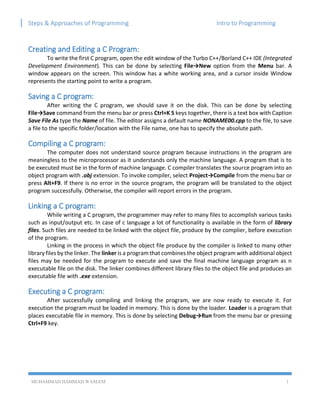
[ITP - Lecture 02] Steps to Create Program & Approaches of Programming
- 1. Steps & Approaches of Programming Intro to Programming MUHAMMAD HAMMAD WASEEM 1 Creating and Editing a C Program: To write the first C program, open the edit window of the Turbo C++/Borland C++ IDE (Integrated Development Environment). This can be done by selecting File→New option from the Menu bar. A window appears on the screen. This window has a white working area, and a cursor inside Window represents the starting point to write a program. Saving a C program: After writing the C program, we should save it on the disk. This can be done by selecting File→Save command from the menu bar or press Ctrl+K S keys together, there is a text box with Caption Save File As type the Name of file. The editor assigns a default name NONAME00.cpp to the file, to save a file to the specific folder/location with the File name, one has to specify the absolute path. Compiling a C program: The computer does not understand source program because instructions in the program are meaningless to the microprocessor as it understands only the machine language. A program that is to be executed must be in the form of machine language. C compiler translates the source program into an object program with .obj extension. To invoke compiler, select Project→Compile from the menu bar or press Alt+F9. If there is no error in the source program, the program will be translated to the object program successfully. Otherwise, the compiler will report errors in the program. Linking a C program: While writing a C program, the programmer may refer to many files to accomplish various tasks such as input/output etc. In case of c language a lot of functionality is available in the form of library files. Such files are needed to be linked with the object file, produce by the complier, before execution of the program. Linking in the process in which the object file produce by the compiler is linked to many other library files by the linker. The linker is a program that combines the object program with additional object files may be needed for the program to execute and save the final machine language program as n executable file on the disk. The linker combines different library files to the object file and produces an executable file with .exe extension. Executing a C program: After successfully compiling and linking the program, we are now ready to execute it. For execution the program must be loaded in memory. This is done by the loader. Loader is a program that places executable file in memory. This is done by selecting Debug→Run from the menu bar or pressing Ctrl+F9 key.
- 2. Steps & Approaches of Programming Intro to Programming MUHAMMAD HAMMAD WASEEM 2 Programming Approaches: Non-Structured Programming Non-structured programming, which frequently working with GO TO branch points to transfer from one part of the program to another part. Using GO TO codes, one could transfer backward, forward, or anywhere else within the program. The problem is that the connections between parts of the program by using GO TO commands can become quite messy. This type of programming is difficult to understand and debug. Non-structured programming of this nature is now viewed as an ineffective programming strategy. To develop good software, developers have to carefully think out and design the programs. In the earliest days of computing, programmers wrote software according to their own whims (desires), with the result that programs were often confusing and difficult to work with. Software today is expected to follow recognized design principles. The prevailing design standards are structured programming and structured design. Structured Programming Structured programming was invented to address the shortcomings of nonstructural programming. Structured programming makes use of the control structures (sequence, selection and repetition). Structured programming does not use GO TO commands. The sequence principle implies that program instructions should be executed in the order in which they appear. The selection principle implies that instructions may be executed selectively using IF-THEN and/or IF-THEN-ELSE statements. These statements work in the following way. IF a condition is met or is true, THEN a specific set of instructions will be executed. If the condition is false, then another set of instructions will be executed. For example, ______________. Alternatively when there are many options, one can employ the CASE statement. The iteration principle indicates that one part of the program can be repeated or iterated a limited number of times. In most computer languages, the iteration may be activated by using REPEAT - --UNTIL or using the WHILE loop and the FOR loop. Modular Programming The Modular Approach to programming involves breaking a program down into subcomponents called modules. Each module is composed of an independent or self-contained set of instructions. Modules are also referred to as routines, subroutines, or subprograms or procedures. Each module is designed to perform a specific task in the overall program, such as to calculate the gross pay of an employee in a payroll program. The advantage of modular programming is the ability to write & test each module independently and in some cases reuse modules in other programs. A program can consists of multiple modules. In addition, there is a main module in the program that executes the other modules.
